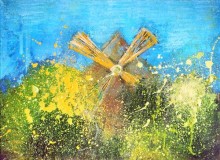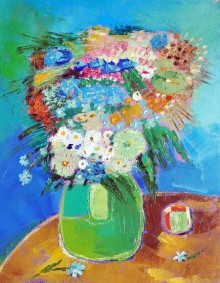Valeria Moskvitina is one of Ukraine’s young artists, who already have fans not only in Ukraine, but also abroad. “Every painting made by the artist has textured color rhythms and dynamic palette knife technique. Paintings that combine landscape and still life elements are especially attractive,” art critic Vlada Diachenko speaks about Moskvitina. “Flowers in a Round Vase, plane vases with tulips and a blue elephant, wild flowers against blue background... There is no difference what kind of flowers is depicted. They always convey a different feeling and they are always bright like rays of joy.”
Valeria was born in Irkutsk, Russia, but since 1991 she lives in Kherson. Here she received art education at a state university and for a few years already has been teaching at Kherson art school No.1. “Being a teacher of a future artist is a truly special mission. It requires one to keep the high level of energy and creative mood at all times to be able to pass it on to children, it also requires self-control and, at the same time, freedom of creative search, because it is important to provide the conditions when your students would engage in art with pleasure and not by force,” says Moskvitina. “I try to inculcate my students with love for beautiful… It is important that people would use this knowledge to create harmony in everything, to bring aesthetics in their everyday life.”
Apart from teaching, the young artist is actively involved in international exhibitions and plain air sessions. She recently came back from Poland, where she visited several artistic events. In Jaroslaw together with the local Catholic parish of King Christ Moskvitina organized a plain air session for students and teachers of Kherson State University. Valeria Moskvitina spoke about these events and other things in her interview for The Day.
“The idea for the project originated after I got acquainted with Andrzej Surowiec, senior priest of King Christ Parish, who kindly agreed to host our students and teachers,” told Moskvitina. “For Ukrainian young artists it is primarily an opportunity to get an experience of working in new surrounding, to meet interesting people, and a chance to present their creative work abroad. Beautiful local nature inspired them to create landscapes, while no customers’ requests or university assignment hanged over them. And the extremely warm welcome of Polish side facilitated the process. Mayor of Jaroslaw Wyczawski welcomed us – ordinary artists like an official delegation. Overall, we felt openness of the officials so unusual for us. Following the plain air session we held an exhibition at the local Catholic cultural center and gave the city a number of our paintings as a gift.”
You stayed in Poland during the time of heated discussion about the Volyn tragedy. Was it sensed in any way in the artists’ environment?
“Once again I had a proof of that the art overcomes all barriers, including political ones. Personally I did not feel any tension in relations with our colleagues. On the contrary, when some local person would touch upon this subject, most preferred not to debate about the past and rather focus on the present: paintings, nature, children, on the things that unite us today.”
What can we see in paintings of Polish artists today and are their motives similar with those presented in paintings of contemporary Ukrainian artists?
“You can sense that Polish artists have more inner freedom. Perhaps, that’s why there are so few realists there, unlike in Ukraine. Thanks to such plain air sessions, which are often held in Poland, artists are constantly experimenting with new styles and techniques, try using various types of paint. Ukrainian artists are more academic, though, of course, today many avant-garde movements are developing both in Ukraine and Poland. I should add that problems of Ukrainian and Polish artists are generally the same. Yes, Polish artists are a little better-off due to the fact that the art is widely popularized in society as something fashionable, necessary and interesting – thus, people buy paintings. However, you can’t say that all talented artists have become successful.”
What was the highlight of this trip for you?
“I got so much positive creative energy and in the last month I finished 14 paintings. After the trip to Jaroslaw I participated in two plain air sessions in northern Poland. An interesting event took place in Kolbuszowa. There I had a chance to meet and talk to many different artists, learn new techniques. Besides, within the framework of the plain air session I held a workshop for children. I spoke to them about Ukrainian art, in particular about the works of Maria Prymachenko and Polina Raiko. It is always interesting for me to tell about our famous artists abroad, to be a kind of a civic ambassador, since people learn about Ukraine also through its artists. And from the example of young students, who got interested in the works of Ukrainian artists and understood what I was saying even despite my poor Polish, I saw the importance of such diplomacy today. Therefore, we agreed with the city administration to organize the exchange for creative children. Soon students of Kherson Art School No.1 will go to study to Kolbuszowa and later Polish children will visit Kherson.”








